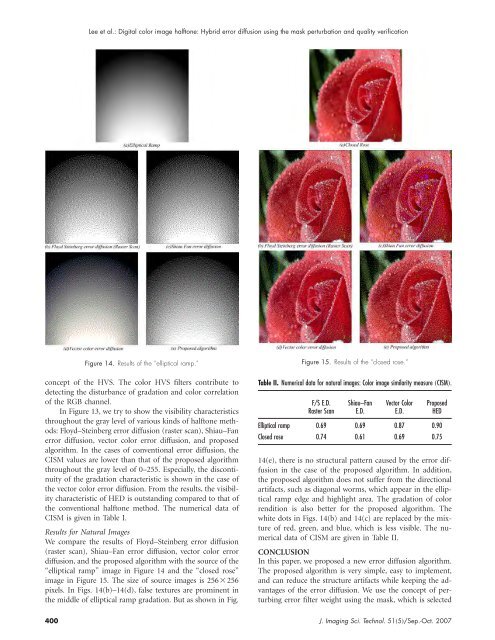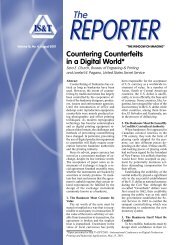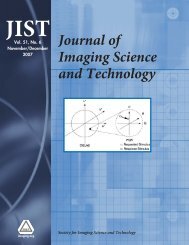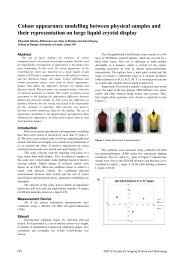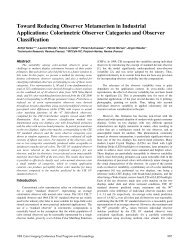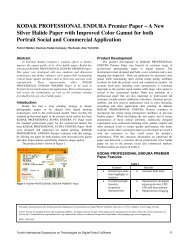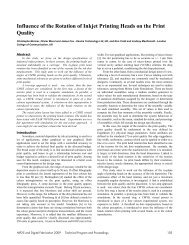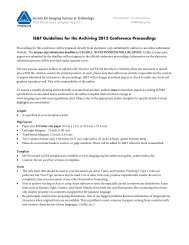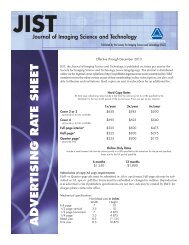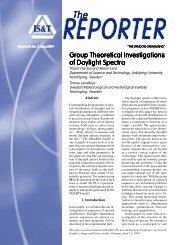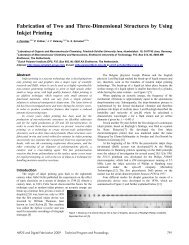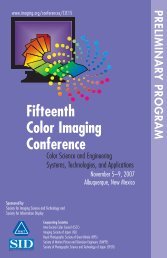JIST - Society for Imaging Science and Technology
JIST - Society for Imaging Science and Technology
JIST - Society for Imaging Science and Technology
You also want an ePaper? Increase the reach of your titles
YUMPU automatically turns print PDFs into web optimized ePapers that Google loves.
Lee et al.: Digital color image halftone: Hybrid error diffusion using the mask perturbation <strong>and</strong> quality verification<br />
Figure 14. Results of the “elliptical ramp.”<br />
concept of the HVS. The color HVS filters contribute to<br />
detecting the disturbance of gradation <strong>and</strong> color correlation<br />
of the RGB channel.<br />
In Figure 13, we try to show the visibility characteristics<br />
throughout the gray level of various kinds of halftone methods:<br />
Floyd–Steinberg error diffusion (raster scan), Shiau–Fan<br />
error diffusion, vector color error diffusion, <strong>and</strong> proposed<br />
algorithm. In the cases of conventional error diffusion, the<br />
CISM values are lower than that of the proposed algorithm<br />
throughout the gray level of 0–255. Especially, the discontinuity<br />
of the gradation characteristic is shown in the case of<br />
the vector color error diffusion. From the results, the visibility<br />
characteristic of HED is outst<strong>and</strong>ing compared to that of<br />
the conventional halftone method. The numerical data of<br />
CISM is given in Table I.<br />
Results <strong>for</strong> Natural Images<br />
We compare the results of Floyd–Steinberg error diffusion<br />
(raster scan), Shiau–Fan error diffusion, vector color error<br />
diffusion, <strong>and</strong> the proposed algorithm with the source of the<br />
“elliptical ramp” image in Figure 14 <strong>and</strong> the “closed rose”<br />
image in Figure 15. The size of source images is 256256<br />
pixels. In Figs. 14(b)–14(d), false textures are prominent in<br />
the middle of elliptical ramp gradation. But as shown in Fig.<br />
Figure 15. Results of the “closed rose.”<br />
Table II. Numerical data <strong>for</strong> natural images: Color image similarity measure CISM.<br />
F/S E.D.<br />
Raster Scan<br />
Shiau–Fan<br />
E.D.<br />
Vector Color<br />
E.D.<br />
Proposed<br />
HED<br />
Elliptical ramp 0.69 0.69 0.87 0.90<br />
Closed rose 0.74 0.61 0.69 0.75<br />
14(e), there is no structural pattern caused by the error diffusion<br />
in the case of the proposed algorithm. In addition,<br />
the proposed algorithm does not suffer from the directional<br />
artifacts, such as diagonal worms, which appear in the elliptical<br />
ramp edge <strong>and</strong> highlight area. The gradation of color<br />
rendition is also better <strong>for</strong> the proposed algorithm. The<br />
white dots in Figs. 14(b) <strong>and</strong> 14(c) are replaced by the mixture<br />
of red, green, <strong>and</strong> blue, which is less visible. The numerical<br />
data of CISM are given in Table II.<br />
CONCLUSION<br />
In this paper, we proposed a new error diffusion algorithm.<br />
The proposed algorithm is very simple, easy to implement,<br />
<strong>and</strong> can reduce the structure artifacts while keeping the advantages<br />
of the error diffusion. We use the concept of perturbing<br />
error filter weight using the mask, which is selected<br />
400 J. <strong>Imaging</strong> Sci. Technol. 515/Sep.-Oct. 2007


